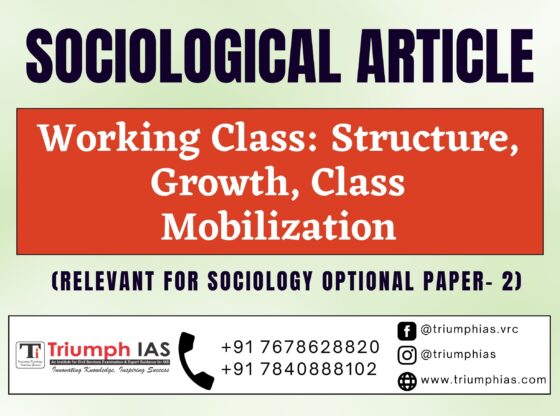Working Class: Structure, Growth, Class Mobilization
Relevant for sociology optional Paper- 2 (Unit- 13 : Social Changes in India)

The working class is a vital component of any economy, serving as the backbone of the industrial sector. It is a group of people who sell their labour in exchange for wages or salaries. The working class includes people from various backgrounds, such as farmers, factory workers, construction labourers, and service sector employees. In India, the working class has undergone significant changes over the years, driven by economic and political factors.
The structure of the working class in India is diverse, and it is challenging to capture its full scope. According to a report by the International Labour Organization (ILO), the working class in India is divided into two broad categories: formal and informal. The formal working class consists of employees who are employed in the organized sector, such as government jobs, large private enterprises, and public sector undertakings. The informal working class comprises people who are engaged in unorganized work, such as street vendors, domestic workers, and daily wage labourers.
The formal working class in India has grown significantly over the years, fueled by the country’s economic growth. In 2019, India’s formal workforce was estimated at 94 million, a growth of 3.8% from the previous year. The formal working class is characterized by job security, higher wages, and social security benefits such as health insurance and pensions. However, the formal sector is highly competitive, and workers face high levels of stress and pressure to perform.
On the other hand, the informal working class is larger than the formal sector, with an estimated 391 million workers in 2019. The informal sector is marked by a lack of job security, low wages, and poor working conditions. Workers in this sector face a host of challenges, including exploitation by employers, limited access to social security benefits, and inadequate legal protections.
The growth of the working class in India has been accompanied by a rise in class mobilization. Workers have organized themselves into trade unions, which serve as a platform for collective bargaining and representation. Trade unions in India are classified into two categories: Central Trade Unions (CTUs) and Industrial Federations (IFs). CTUs are national-level organizations that represent workers across various sectors, while IFs are sector-specific unions.
The trade union movement in India has a long and rich history, dating back to the early 20th century. The first trade union in India was established in 1918, and since then, the movement has grown in strength and influence. The trade union movement in India has played a vital role in securing workers’ rights, improving working conditions, and advocating for better wages.
However, the trade union movement in India faces several challenges, including a lack of unity among unions, fragmentation across sectors, and inadequate legal protections. Moreover, the rise of neoliberal policies in India has led to a decline in unionization rates, as employers seek to limit the power of unions.
In conclusion, the working class in India is a diverse and complex group of people who play a crucial role in the country’s economy. The formal sector has grown significantly over the years, but the informal sector remains larger and faces several challenges. The rise of the working class has been accompanied by a growth in class mobilization, with workers organizing themselves into trade unions. However, the trade union movement in India faces several challenges, and there is a need for greater unity and legal protections to ensure workers’ rights are protected.
For more such free UPSC notes, Articles, News & Views Join our Telegram Channel. https://t.me/triumphias
Click the link below to see the details about the UPSC – Civils courses offered by Triumph IAS. https://triumphias.com/pages-all-courses.php


